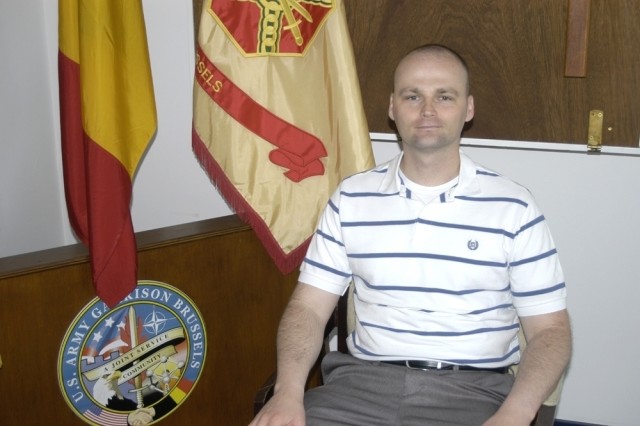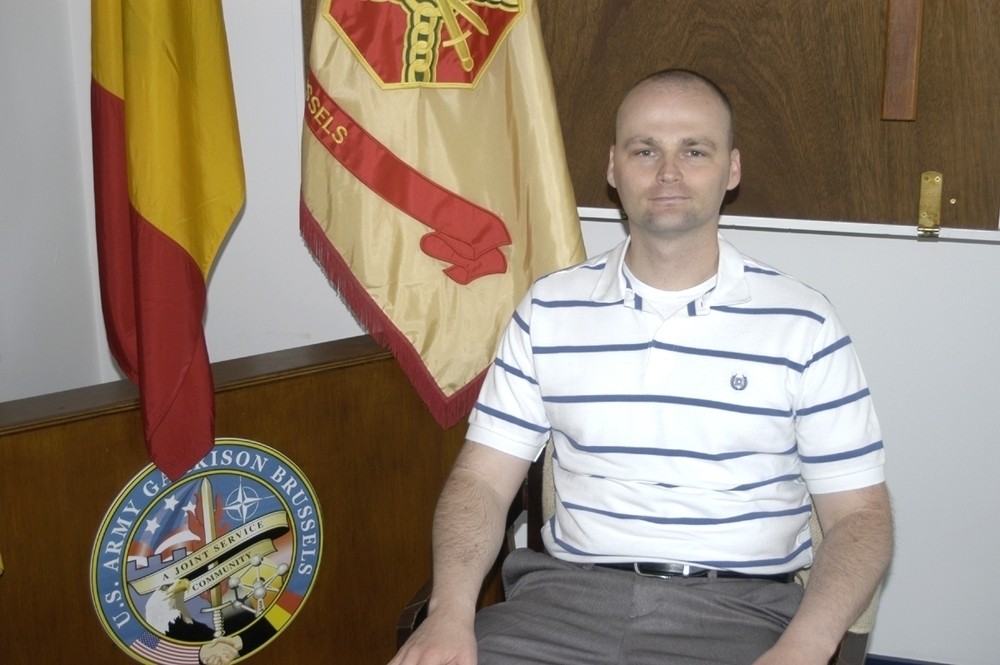
BRUSSELS, Belgium Aca,!" U.S. Army Garrison Brussels, Belgium, recently held its recognition ceremony honoring the vibrant volunteers who generously give so much time and effort to the Brussels Community.
Part of the ceremony involved the presentation of a large-denomination check to the garrison commander. The check translates estimated volunteer hours into a man-hour cost figure, i.e., what those hours would have cost had they been paid for by the U.S. government.
The Brussels community of volunteer man-hours for the past year translated into $437,950 - a dollar or man-hour metric most of us can instantaneously grasp.
But it doesn't necessarily follow that "that which counts best counts most."
Meet Staff Sgt. Peter Bouck, one of the honorees at the ceremony whose contribution to his fellow man is no less significant for being essentially unquantifiable.
For Bouck is one of those select volunteers who donated life.
Bouck is a voluntary member of the Department of Defense's C. W. Bill Young Marrow Donor Program, and he recently traveled to the U.S. under the program's auspices in order to donate some of his stem cells to a patient.
The C.W. Bill Young Marrow Donor Recruitment and Research Program is a DoD program established under Public Law and named after Florida Congressman Bill Young.
It seeks to recruit volunteer DoD personnel from all walks (active duty, family members, civilian employees) as potential marrow donors.
The DoD program is part of a broader National Marrow Donor Program. Nationally, the U.S. military is a targeted resource for donations, because its members, more so than with any other large organization, tend to meet the strict health and age requirements stipulated for donors.
Bouck, who hails from Middleburgh, New York, serves as the garrison's assistant truckmaster and dispatch noncommissioned officer-in-charge.
He previously served four years in the Marine Corps and has been on active duty in the Army since April of 2003.
His Army time has included a year-long deployment to Iraq in 2004-05. He and his wife of six years, Shannon, arrived in Brussels in September 2006. They recently (June 4th) became the proud parents of their first child, son Preston, born here barely three weeks after Bouck flew to the U.S. for a week to make his lifesaving donation to a patient who urgently needed treatment.
How did Bouck become a donor'
"I was at Fort Bragg, N.C., before deploying to Iraq, and I was helping a colonel in-process. I happened to overhear him being asked whether he'd like to become a bone marrow donor. I listened to the briefing, and decided getting pricked with a needle wouldn't hurt me, so I signed up."
Bouck further explains his simple rationale: "If I can save somebody's brother or father, I'll go through a little discomfort."
DoD's executive agent for this program is the Navy.
When told of Bouck's words, retired Navy Medical Corps Capt. Robert Hartzman of the Naval Medical Research Institute in Bethesda, Md., quickly pointed out that the Brussels Soldier was being overly modest.
"The procedures [there are two types] are not something trivial," he explains. "When Bouck came to one of our facilities, he was subjected to a 5-day procedure called apheresis, by which blood stem cells were collected from his circulating blood, four to six hours per day. It's not necessarily painful, but it represents an extraordinary voluntary commitment on his part."
Hartzman is adamant when saying, "What Bouck did is one of the kindest, most generous and most selfless acts I know. By going through with this complicated procedure and donating his stem cells, he's literally giving the gift of life to someone, who, odds are, he'll never meet. I can't think of many volunteer actions more generous than that."
Members of the DoD program, like Bouck, are placed on orders and flown to the greater Washington, D.C. area to take part in the donation procedure at one of three sites. They incur no financial cost for participating in the program.
According to Hartzman, there are some 475,000 DoD personnel registered in the program, awaiting the call, "We think you're a match."
Hartzman explains: "A crucial part of the registration process is the determination of the potential donor's HLA, or human leukocyte antigens."
HLAs are markers found on most cells in your body. A close HLA match between patient and donor is the most important factor in selecting the best bone marrow donor for a patient.
Matching donors to patients in need has been made easier by technology.
"We're very fortunate that advances in technology have really made this simple. Qualified donor candidates are sent a Buccal swab kit, which they administer themselves and then return to us via a provided mailer," Hartzman says. "We analyze the returned swabs in one of our labs, type the HLA, and then enter the data into a national data base."
Once entered in the National Marrow Donor Program's Registry, marrow transplant teams throught the U.S. can search the NMDP file to match potential donor HLA type to HLA of patients who need a transplant.
Potential matches are identified, the registered donors are contacted, and a chain of events similar to what brought Bouck to the Washington area for his donation is unleashed.
According to Hartzman, the organization conducts donor recruitment drives at U.S. military facilities, while recruiting individual DoD-affiliated donors from overseas.
For those interesed in becoming a donor, Hartzman says they need to just send an e-mail to recruitment@dodmarrow.com and ask for information about the Marrow Donor Program.
As part of the registration process, there are several steps including getting the commanding officer's signed consent indicating there is a high chance (about 10 percent) that a donor who makes it to the registry will have to donate marrow.
Hartzman encourages interested DoD personnel to visit the program's website, www.dodmarrow.org.
Bouck is one of those "1-in-10" volunteers whose number came up. Now that he's completed the process he started four years ago, what does he think' His answer is indirect- and to the point: "I like taking care of people."

Social Sharing